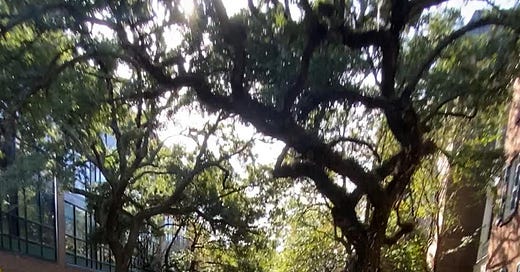Lime bikes: just the kind of juice American racing needs
Sometimes the wrong bike for the job is the right bike for the plot
I’ve ridden a few Lime bikes this summer for very practical responses. They have been a surprisingly elegant solution to getting things done without having a readily available car during travel outings.
It takes a second to get used to the clunky foibles of the inevitably bedraggled bikes that get kicked around by drunks the world around, but within a minute I get that scintillating feeling of wind on my neck and freedom in my legs. Within two minutes I am thinking about how much cycling is missing an opportunity to bring these accessible two-wheel tools into our umbrella.
Normally I don’t do anything about these big thoughts because I get off the Lime bike and do whatever I had to do, but not this last time.
Here in Charleston as I was shuttling myself between pre-wedding errands, I kept thinking about these bikes and the idea snowballed. With Southern vibes saturating the streets around me, I couldn’t help but think back to the southern spring in Georgia and South Carolina and the criteriums that liven up the nights of Speed Week and just how sweet it would be to bring the Lime bikes to center stage in the most absurd way possible.
Criteriums already are a type of absurd circus of a sport. Especially the big ones function like attractions where what sits at the center of the event is as important as the peripheral party that most people come to. That being said, when the bike race hums, everything benefits. So imagine what kind of fun would come if a company like Lime fronted some of the money for the party and the only cost was the experiment of getting strong riders on Lime bikes going in circles as fast as they can.
To me, that is the kind of wacky shit that gets the people going. Nothing could extend the right type of olive branch to an uninitiated public that might be wary of a pack of cyclists on expensive bikes to begin with than getting those same cyclists on bikes anyone can grab in almost any city across the country.
While we could get into specifics about the [Insert Town Here] Criterium presented by Lime and how cool the lime green branding would be, and how the company could encourage people to come to the event on Lime bikes for some kind of promotion, and how the Lime bikes could get decked out for the special Lime bike race, and how the race could incentivize some of the best riders to do the Lime event for like $2,000 or something, and for the impact the race could have on Lime’s visibility in a tangible way to get more people on bikes instead of cars, and so on and so forth – but instead I think the focus should instead about how much creativity could be applied on the margins of the sport for a big difference.
Outside of the NCL, which took a far too big stab at reinventing road bike racing in the United States, the sport has clung to its history and heritage in a big way. That, for the most part, works really well. Criterium history in the United States is deep and those races aren’t going anywhere. But can we do more to increase the umbrella and give these great races juice? Absolutely. Especially if we continue to lean into the weirder, wackier aspects that realize the party is more important than the practical sport at the center. Both are necessary, but one makes a lot more of an impact than the other.
Race directors, my line is open, let's talk.
For your eyes and ears
The 2025 Tour de France and Tour de France Femmes routes were launched this week and the routes look very interesting, albeit fairly traditional for the men. Of the two races, the women’s edition is the one I cannot help but look forward to the most as many different storylines swirl around the next rendezvous of the world's finest. For the men, it is Pogačar and Vingegaard round five. With each passing year, their battle seems to look more and more like two sports teams in a seven-game series for generational bragging rights. On a year-by-year basis, that makes things a bit stale, but I have no doubt we will look back at this period with some degree of romance in not too long.
A side of something else
Trigger warning: political territory to come. Proceed with caution.
I try to avoid politics here the best I can because, to be honest, I am beyond over it. In a different period, I could be into politics on a professional level having studied both political science and journalism in school, but frankly, I’d rather write about literally anything else. That is not to say I don’t have my opinions, I just don’t feel compelled to dwell on them, especially professionally.
Nevertheless, the dialogue around one political argument recently has me wanting to say something, even if it isn’t partisan. I think everyone has lost the plot over the Washington Post’s decision from the top to not endorse a political candidate.
In this increasingly tribalistic political climate where an increasing amount seems to be at stake, I see the reason for papers and media outlets to put their weight and expertise behind a candidate. They are the organizations that, in theory, are biased not by political persuasion but instead biased to objective facts. But I don’t see the merit of using that grounding in fact-based reporting to pick a side in this battle, beyond the normal function of a paper and the normal function of an editorial board.
In this climate, a bias toward objective fact is now, from my perspective, indistinguishable from a bias towards one part. On a several issues of incredible importance to me as a citizen of the United States, one who likes to be outside and who does not like to fund war crimes, the facts point to the Democratic ticket without invoking any kind of subjective opinion.
In this case – where you have this clear divide between what I believe to be a factual narrative versus counterfactual belief-based arguments – what is the point of labeling that difference and endorsing a partisan candidate? Rather than letting the reporting speak for itself and individual opinion writers making personalistic opinions?
Doing more than that if anything pulls the argument and the bias of a paper away from being a clear bias towards fact-based reporting perspectives and instead towards something murkier that will only do more damage to a national information climate where objective arguments are hidden under a massive amount of counter-factual conspiratorial bullshit.
Surprisingly, I seem to be alone in having this perspective amongst those who lean left these days which feels odd given what other arguments political pundits have said, but that’s alright by me. It just means I don’t have other media to link to to echo some of my sentiments. Nevertheless, there were some other good stories out there as the election neared. Once again, Derek Thompson brought some fantastic storytelling to the table with his Plain English podcast on what a small town in Pennsylvania says about the whole country that is facing this tense political fight which will come to blows on Tuesday.





